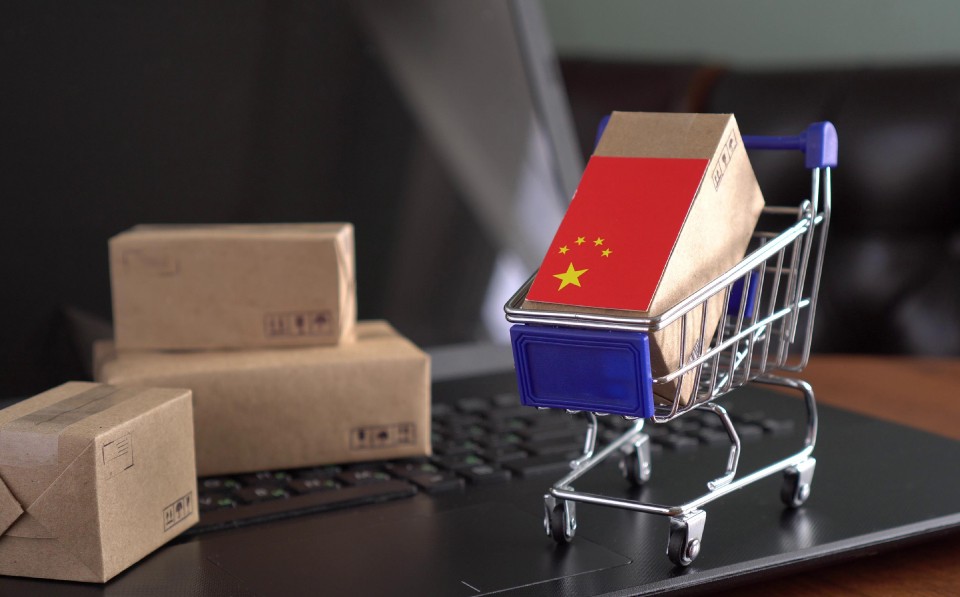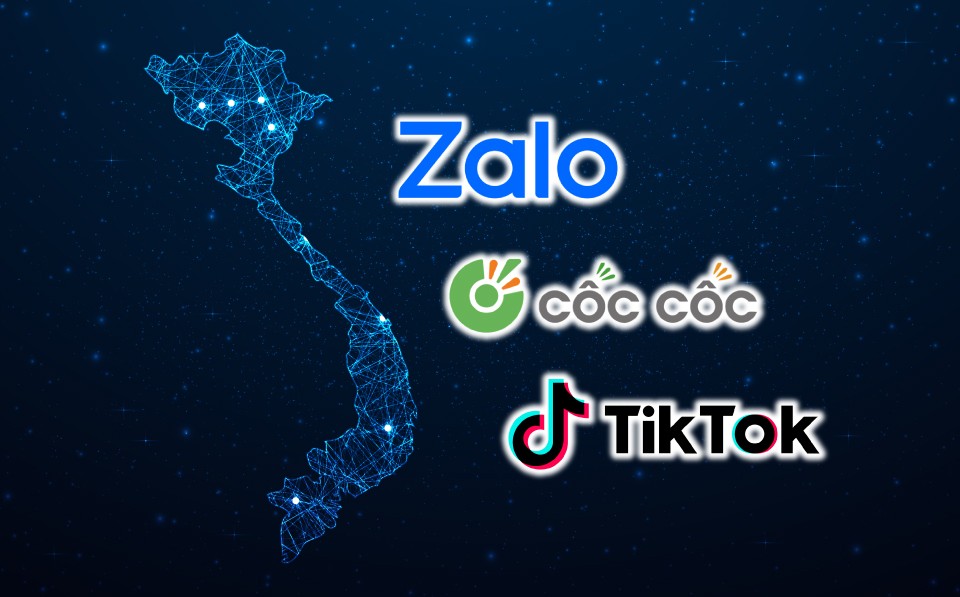Digital Travel Marketing Strategies in 2022: Recovering in the Post-Pandemic World
29 Apr , 2022
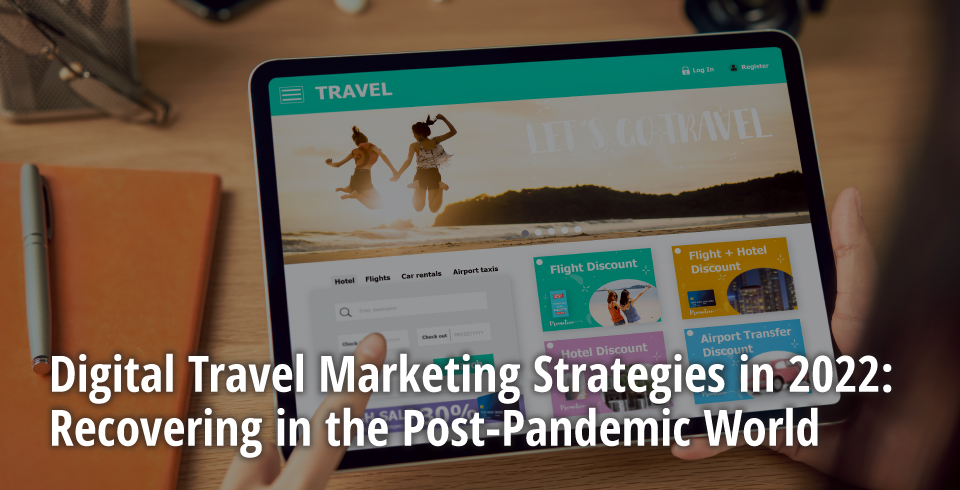
Get ready for your digital travel marketing strategies in 2022! As the coronavirus is weakening and the global mortality rate drops from 10% in 2020 to 0.9% in 2022, we are getting used to living with Covid while the world starts recovering in all aspects. At least 30 countries including Ireland, Denmark, Thailand, Norway, Canada, and Austria, have eased their travel restrictions since February 2022 in addition to easing restrictions in daily life. Canada and France no longer require vaccine passports to be presented in public. Australia has reopened its international border for the first time in nearly two years that tourists and business travelers, who have taken two doses of the COVID-19 vaccination, will be permitted to enter Australia without being quarantined. Isn’t the removal of entry restrictions across the world the best news for travelling industry?
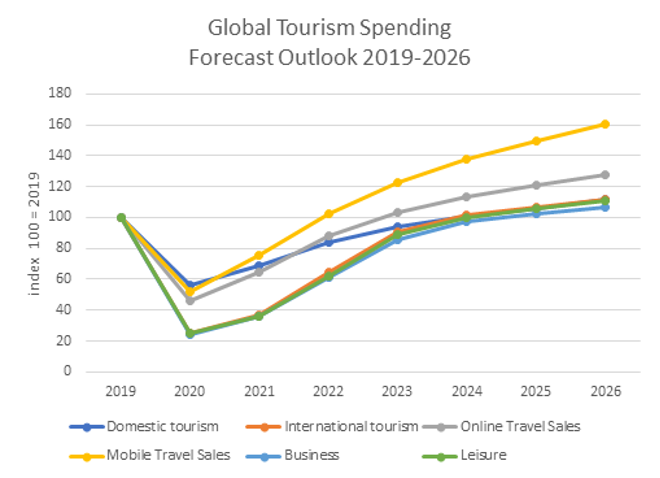
Source: Euromonitor International
According to the 2022 Global Economic Outlook Report, the resumption of international tourism will hasten the recovery of leisure tourism. Global tourism spending reached its lowest point at the start of the epidemic in 2020, remained low between 2020 and 2021, but then steadily rose back to the pre-pandemic levels by 2022. Furthermore, the International Air Transport Association (IATA) announced an 82.3% increase in air travel demand for the past year. Perceiving potential tourism recovery in 2022, in order to stand out from the competition and reap maximum benefits, you should seize the opportunity to implement cost-effective and result-oriented digital travel marketing strategies. If you want to capture as many potential travelers as possible when travel resumes at full pace, the following article will help you understand:
Digital Transformation in Travel that You Can’t Ignore
Why Digital Marketing Strategy is Essential for Travel Industry in 2022
3 Effective Digital Travel Marketing Strategies
1. Why Digital Marketing Strategy is Essential for Travel Industry in 2022
Before the pandemic outbreak, most individuals have been already using the Internet to help with their travel-related decisions. According to statistics, 70% of travelers conducted trip research on their smartphones in 2019. It demonstrates the need of having a mobile responsive website for the convenience of travelers. In addition, travel booking is dominated by the online market. Every year, 148.3 million travel reservations are made online. In 2018, 82% of all travel bookings were made online using a smartphone app or website, majorly with no human assistance involved. Correspondingly, travel agents and affiliates accounted for 24.3% and marketplace bookings accounted for 9.1%, whereas direct internet bookings accounted for 66.7% of all bookings.
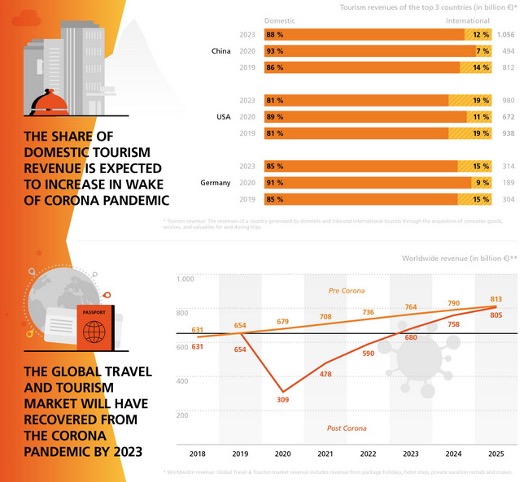
Source: Statista
The worldwide online travel agency industry was worth roughly $744.7 billion in 2019, with a compound annual growth rate (CAGR) of 7.9 percent since 2015. By 2023, 700 million individuals would have booked their hotel rooms online. Tourists now can basically do everything online that they prefer using smartphones or computers to do destination research, buy airline tickets, reserve hotels or B&Bs, purchase travel-related products, and organize trip.
Digital devices and tourism revenue become inseparable. As a result, online travel marketing is far more significant in this era and determines the success of travel companies. With Covid-19 restricting our life, more consumers rely on technology to fulfill all their needs, such as remote work, distance learning, and entertainment. It is not difficult to imagine that during the post-pandemic time, an increasing number of travelers will abandon conventional approaches in favor of using the Internet to make purchase travel-related products. And that is why if you can grasp online travel marketing strategies well, you are already well on the way to succeed in booming tourism.
2. 3 Effective Online Travel Marketing Strategies in 2022
The tourism industry has been severely affected by the pandemic without a doubt. To maximize conversion value within cost boundaries and avoid additional costs, it is recommended that your 2022 online travel marketing strategies should focus on return on advertising spend (ROAS). Besides, according to Google search data, flights and accommodation are usually booked 12 weeks ahead of time. Travel companies should start running your online travel marketing strategies as early as possible before the tourism recovery actually begins and generate valuable digital traffic to prepare for the coming wave of tourism.
2.1 Social Media in 2022 Digital Travel Marketing Strategies
Social media is particularly advantageous to your online travel marketing that it is proven to be:
• Improving travel brand awareness
• Increasing high-quality inbound traffic to the travel sites
• Increasing travelers’ loyalty to your brand
• Cost-effective with a huge amount of travel consumers reached daily
The border restrictions have reduced the number of visitors in these few years, yet many travel companies did not stop there. They utilized social media marketing to keep their target clients exposed, using appealing visuals and content to intrigue their interest in traveling and, hence, capture new customers if entrance restrictions are eased someday. With the fact that the social media market has expanded significantly over the last decade, there is no doubt that it has had a significant influence on travel industry. Instagram, Facebook, and Twitter would continue to be the major social media platforms in 2022. Travel companies will be able to acquire substantial attention and efficiently reach target clients at a lower cost if these social media platforms are used.
In the case of Instagram, a Facebook study in 2019 revealed that 67% of travelers use Instagram to get travel inspiration before booking a trip, and once a trip is booked, they will continue to hunt for more detailed travel inspiration on the platform. Likewise, according to Schofields’ research, over 40% of tourists aged 18-33 consider "Instagrammability" while picking their next vacation destination. It indicates that people are increasingly turning to social media for travel inspiration. For example, they rely much on KOL’s reviews of the local restaurants and tourist spots. Many people would even imitate photos or videos from their favorite KOLs in the hope of experiencing the same as the KOLs. Social media is effective in triggering travelers’ interest in places, where they have little idea of, right after they see a few attractive photos in their newsfeed. At this point, it is only a few clicks away from actually visiting the destination.
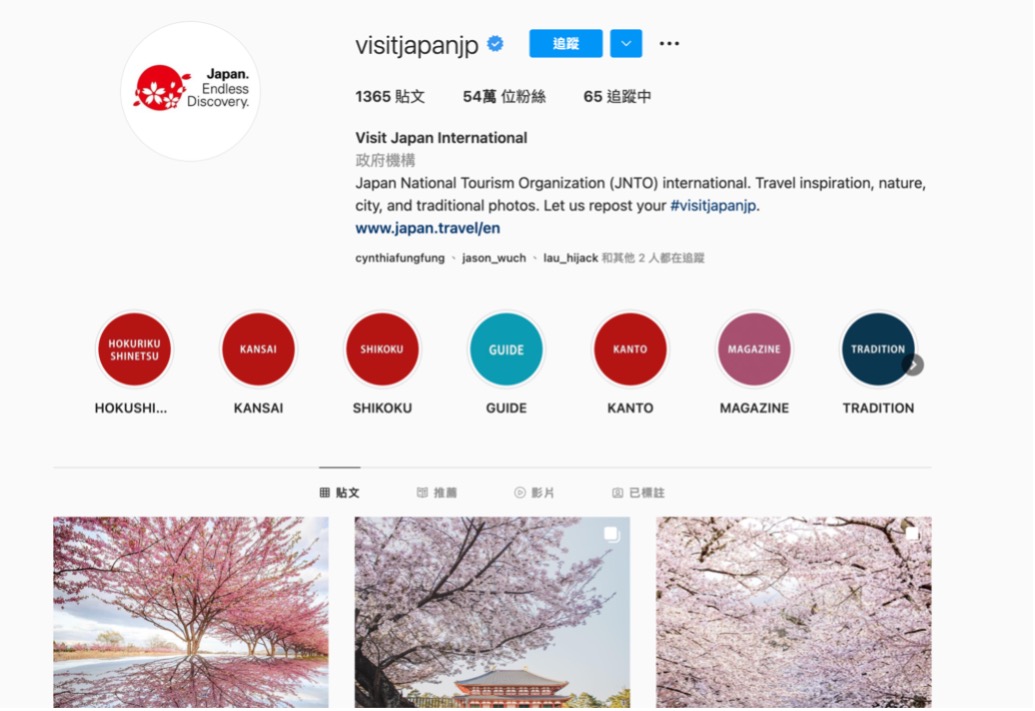
Japan National Tourism Organization (JNTO) is one example of utilizing social media in their online travel marketing strategy. Its Instagram account, visitjapanjp, has over 540k followers who are interested in travelling in Japan. Even though people cannot visit Japan amid the pandemic, they are keen on keeping up with the latest local information which leads to over 15K engagements in one post.
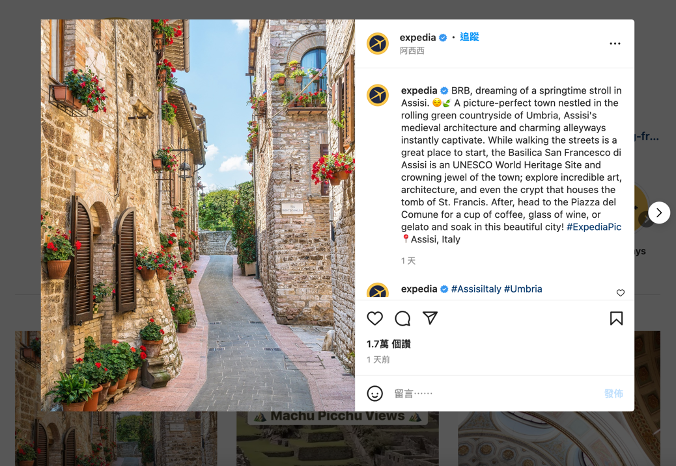
Expedia, the well-known digital travel service platform, is also devoted to running its social platform, with 363k followers. It shares the most beautiful landscapes found around the world every day to maintain its target audience’s passion in travelling.
For travel companies, social media is one of the most cost-efficient and winning digital channels for travel marketing to boost user spending. However, the collection of aesthetic images and all the content creation work take time and effort. Some companies nowadays, therefore, choose to hire social media specialists to execute and manage their social platforms with reliable expertise and experience. AsiaPac is one of the professional agencies which has multiple local offices across the Asia Pacific region to handle your social media channel in the purpose of travel marketing. Click here to know more about our years-long experience.
2.2 Leverage Influencers in 2022 Digital Travel Marketing Strategies
Influencers in travel marketing offer many advantages that can help your travel business grow :
• Creating viral effect for travel destinations
• Building trust for your travel brands
• Reaching the potential travelers
• Driving conversions with the influencers’ CTA
China market is a good example to showcase the effect of influencer marketing on social media. Chinese users prefer local social media such Xiaohongshu, Weibo, WeChat, Douyin, and several other platforms. The number of daily active users on WeChat is one billion, 400 million on Douyin, 200 million on Weibo, and millions on Xiaohongshu, according to the platforms' official statistics. And last year, social commerce in China reached $242 billion with influencers generating a great impact on purchase decisions and thus the brands’ sales revenue. As you may already expect, China social media platforms have become a must-have digital channel for enterprises to enter the market, and so as travel companies like you.
Influencer marketing will be your ticket to success in 2022 digital travel marketing to win in the fierce China market.
Influencer livestreaming is one of the popular travel industry's travel marketing tactics for promoting brand values and revenues. Many well-known tourist spot government officials, travel entrepreneurs, and travel influencers have live-streamed on Chinese livestreaming platforms in recent years to attract brand attention and strengthen the brand value of tourism products and customers' interest in them.

For example, James Liang, the founder of China's well-known travel company, Ctrip Group, became a well-known influencer streamer in the travel sector by livestreaming every Wednesday while dressed up in more than 20 identities from nine eras.
Weibo and Ctrip collaborated to launch "Liang Jianzhang BOSS Livestreaming Room," in which Liang cosplayed Bao Qingtian and offered live aircraft and wine products. On that day, its Weibo live stream had over 10.19 million total viewers, Weibo topics were viewed by over 170 million people, and his Weibo account @携程梁建章had risen to over 10.19 million followers. Liang’s campaign has incredibly showcased the power of influencer livestreaming in terms of digital travel marketing: the number of microblog readers jumped 45 times over the previous week, the number of interactions increased by 130 times, and the number of live broadcast views increased by 50 times. The total GMV hit 33.46 million, with 48,549 rooms/night booked, and the special Eastern Airlines tickets were sold out within 3 minutes of the broadcast. Influencer livestreaming is highly recommended as an online travel marketing strategy in 2022.
WeChat Official Account(公眾號) is another popular social media platform adopted in travel marketing strategies by China influencers, who are more focused on building brand awareness of travel industries and drawing travelers' attention to travel locations and products on Weibo than on other social platforms.
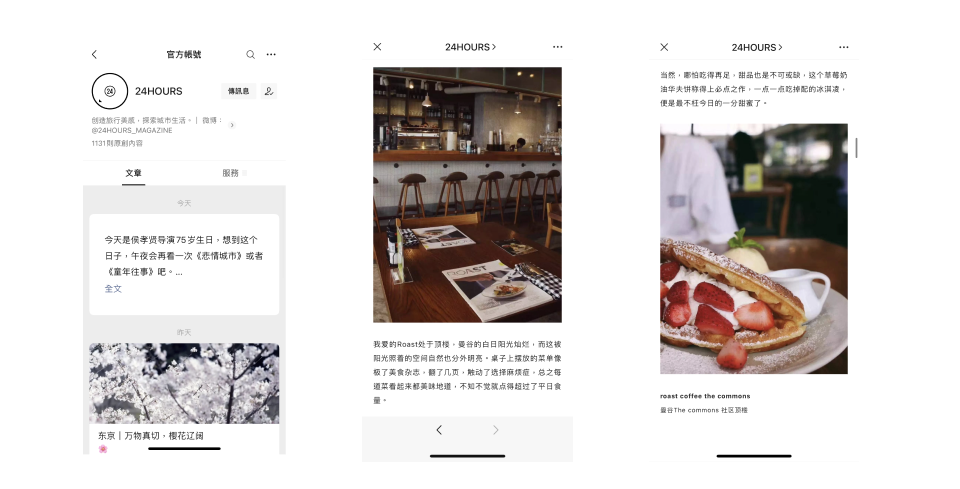
24HOURS, a WeChat Official Account that focuses on "recommending beauty with words," thrives at narrating stories and presenting a place or a day in a city with layered words. 24HOURS cooperated with Airbnb to present stories of B&B owners, the environment, and the review of B&Bs. It has aroused its audience's interest in not only reading the posts to get a glimpse of such a high quality and slow-paced life, but also visiting the B&Bs in person later. 24HOURS’ consistency in traveling content and style in the collaboration campaign has successfully formed the desired travel marketing effect for Airbnb.
The average monthly audience of 24HOURS posts is around 16,000 individuals which is an outstanding statistic for a travel influencer. Although the result is not as immediate as live streaming, collaboration with influencers is still a very effective digital travel marketing channel to help travel companies build up connections with consumers during the post-pandemic era. It wins potential clients and sales promptly when travel restrictions are completely eased.
Businesses who seek to leverage influencer marketing may face challenges without a local team. For example, it can be difficult to pinpoint and contact the most brand-appropriate and famous influencers in your target market. AsiaPac has teams of localized talents across the Asia-Pacific region that can help your company with a customized and up-to-date influencer campaign for your digital travel marketing strategy in 2022.
2.3 SEM & SEO in 2022 Digital Travel Marketing Strategies
The emphasis of businesses associated with arranging accommodation or purchasing travel products may differ from those of particular travel businesses such as destination businesses, airlines, and hotels. According to statistics, 80% of travelers use a laptop to plan their trip, and 80% prefer to do all their travel research online. 48% of passengers prefer to plan their trips on their smartphones. The first step in their research is to discover and locate travel products via search engines like Google or Baidu. As a result, if your travel company overlooks the value of Search Engine Marketing (SEM) & Search Engine Optimization (SEO), which sound to be the most common digital marketing strategies, you may be missing out on a lot of traffic and conversion potential.
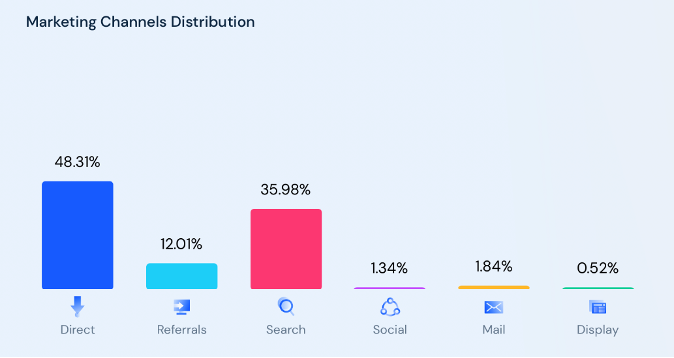
Source: similarweb
Booking.com, a well-known online travel agency, is a good example of utilizing SEO and SEM in their travel marketing strategies. Booking.com is placed the third in the travel accommodation and hotels category, with 457.7 million website visitors in March 2022, according to similarweb. The effective SEM and SEO channel has obtained nearly 40% of Booking.com’s total traffic and client base, and it is possible to your travel companies as well.
Google may have come to your mind when we talk about search engines. In fact, the target market of your travel marketing strategies in 2022 determines the choice of search engine for your SEM and SEO. For instance, reigning supreme in the global search engine market, Baidu advertising is particularly suggested for your travel marketing strategies targeting China travelers, who occupies 40% of the total outbound tourism of Asia and the Pacific. As the largest search engine in China, Baidu is effective in increasing your travel website visitors from China and converting enquiries into sales.
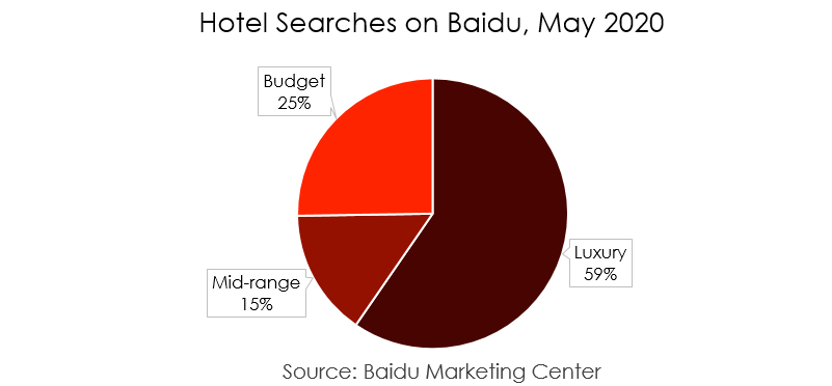
Before and in the early stage of the pandemic in 2020, Baidu has published a report on its web searches which revealed the high demand of travel consumers. There was a 22% increase in accommodation and a 14% increase in all tourism-related topics. Besides, most the Chinese are willing to pay for mid-range and high-end hotels with 74% of the total hotel searches. SEM and SEO in Baidu advertising definitely is a considerable online travel marketing strategy with such a high travel intent, which we believe is going to resume in 2022.
3. Summary
After two years of frigid winter, the lessening of the pandemic has finally brought light to the travel industry. Travelers who have been affected by the disease for more than two years are more likely to generate a larger traveling frenzy, which might lead to huge revenues for your travel companies. If you are interested in having the suggested social media marketing, influencer marketing, and search engine marketing, or even exploring more for your 2022 digital travel strategies, go straight to AsiaPac's skilled professionals, so you can effortlessly develop a personalized, strategic plan along with your travel marketing goals for the travel recovery in 2022.
About AsiaPac Net Media
With an extensive digital marketing experience of serving more than 2,500 clients across the region in sectors such as education, travel and hospitality, finance, Government and others, AsiaPac’s expert team is highly recognized for the excellence in providing performance-driven services to customers from Hong Kong, Taiwan and the PRC, and global corporates targeting Asia markets. So far, our company has covered services for more than 20 educational institutions across the regions, including promoting MBA programs of the University Grants Committee (UGC)-funded universities in Hong Kong, boosting conversions for overseas education agents, and bridging international markets to Asia, especially China. If you’d like to learn more about AsiaPac and the work we’ve done, visit our Cases page. For more information on AsiaPac and our services, please contact us at info@asiapac.com.hk.


